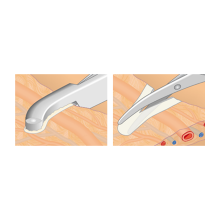Project Overview
Bipolar radiofrequency-induced thermofusion is a commonly used technique in both open and laparoscopic surgery to seal off blood vessels through thermal fusion of the vascular walls. The quality of the sealing as well as the extend of damage to the sorrounding tissue are subject to a complex variety of electrical, mechanical, thermal and biological factors.
This project focuses on new model-based control strategies for the thermofusion process to replace the existing empirical methods in order to optimize the fusion quality and minimize the lateral tissue damage. The ISYS develops, in cooperation with our industry partner Erbe, mathematical models for bipolar radiofrequency (RF)-induced thermofusion and the resulting lateral tissue damage.
These models will be validated in ex vivo and in vivo experiments based on typical problems that arise in clinical practice in the fields of urology and gynecology. The experiments will be designed together with and performed by our university partners at the University Hospital Tübingen.
Based on the validated models we seek to optimize the control of the surgery tools used for RF-induced thermofusion to minimize the lateral tissue damage while ensuring best possible sealing quality as well as good usablity during surgery.
Publications
- , “In silico evaluation of geometry variations with respect to the thermal spread during coagulation of egg white using bipolar vessel sealing instruments”, BioMedical Engineering OnLine, 2016, doi:10.1186/s12938-016-0238-2
- , “Optimized generator modes for bipolar vessel sealing”, IEEE Conference on Control Applications (CCA), Sydney, NSW, Australia, 2015, pp. 1862-1867, doi:10.1109/CCA.2015.7320881
- , “Finite-Element-Modeling of Egg White as a Substitute for Tissue Coagulation during Bipolar Radiofrequency-Induced Thermofusion”, International Conference of the IEEE Engineering in Medicine and Biology Society (EMBC), 2015, doi:10.1109/EMBC.2015.7319708
- , “A Mathematical Model of Bipolar Radiofrequency-Induced Thermofusion”, International Conference of the IEEE Engineering in Medicine and Biology Society (EMBC), Chicago, IL, USA, 2014, pp. 5683-5686, doi:10.1109/EMBC.2014.6944917
Partners
- Universitätsklinikum für Urologie, Tübingen
- Universitätsfrauenklinikum Tübingen
- Universitätsklinik für Allgemeine, Viszeral- und Transplantationschirurgie, Tübingen
- ERBE Elektromedizin GmbH
Contact

Cristina Tarín
Prof. Dr.-Ing.Deputy Head of Institute



